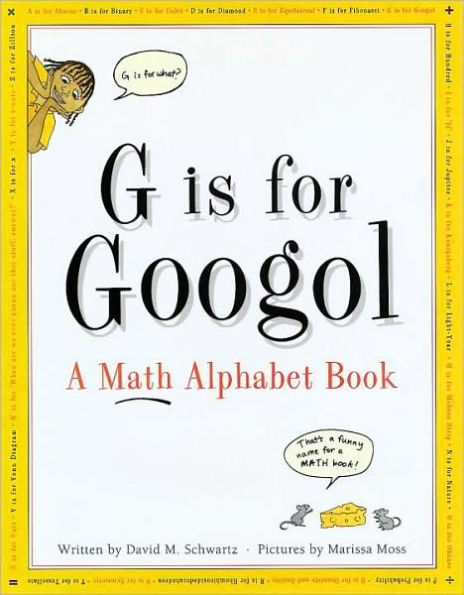B is for Binary, F is for Fibonacci, P is for Probability... even a small sample begins to give you the idea that this is a math book unlike any other. Ranging freely from exponents to light-years to numbers found in nature, this smorgasbord of math concepts and trivia makes a perfect classroom companion or gift book for the budding young mathematician at home. Even the most reluctant math student will be drawn in by the author's trademark wit, Marissa Moss's quirky illustrations and funny captions, and the answers revealed in W is for " When are we ever gonna use this stuff, anyway?" Download the G is for Googol Teacher's Guide(300K)
B is for Binary, F is for Fibonacci, P is for Probability... even a small sample begins to give you the idea that this is a math book unlike any other. Ranging freely from exponents to light-years to numbers found in nature, this smorgasbord of math concepts and trivia makes a perfect classroom companion or gift book for the budding young mathematician at home. Even the most reluctant math student will be drawn in by the author's trademark wit, Marissa Moss's quirky illustrations and funny captions, and the answers revealed in W is for " When are we ever gonna use this stuff, anyway?" Download the G is for Googol Teacher's Guide(300K)

G Is for Googol: A Math Alphabet Book
56
G Is for Googol: A Math Alphabet Book
56Hardcover
Related collections and offers

Product Details
| ISBN-13: | 9781883672584 |
|---|---|
| Publisher: | Random House Children's Books |
| Publication date: | 09/28/1998 |
| Pages: | 56 |
| Sales rank: | 53,460 |
| Product dimensions: | 8.85(w) x 11.31(h) x 0.40(d) |
| Lexile: | IG760L (what's this?) |
| Age Range: | 8 - 12 Years |
About the Author
Customer Reviews
Explore More Items
All year the half-bloods have been preparing for battle
In this fourth
A guide to the bestselling series, featuring original short stories, puzzles and games
How do you handle an encounter with Medusa on the New Jersey interstate?
Percy Jackson and his army of young demigods do battle with Kronos on the streets of Manhattan as Percy's sixteenth birthday approaches and his fate looms even closer.
Magnus Chase, a once-homeless teen, is a resident of the Hotel Valhalla and one of Odin's chosen warriors. As the son of Frey, the god of summer, fertility, and health, Magnus isn't naturally
The Magnus Chase and the Gods of Asgard trilogy may have concluded, but we haven't heard the last of our favorite peeps from the Nine Worlds. Join Hearthstone, Blitzen, Samirah, Alex, Jack, T.J.,
At last, the
When Gerald was a child he was fascinated by fire. But fire is dangerous and powerful, and tragedy strikes. His substance-addicted mother is taken from him. Then he loses the loving generosity of a
“A gutsy, candid, and compelling story. It speaks volumes.” —School Library Journal (starred review)
“Unflinching and
Diamond knows not to get into a
In this “searing work of historical fiction” (Booklist), Coretta Scott King Award-winning author Sharon M. Draper tells the epic story of a young
Read the ground-breaking science fiction and fantasy classic that
